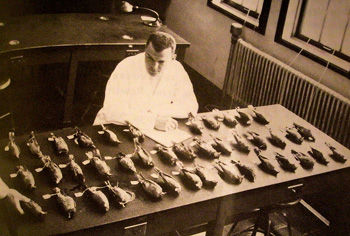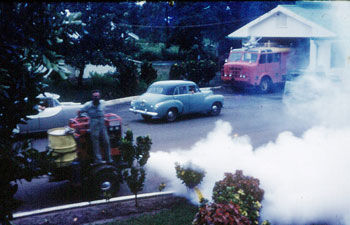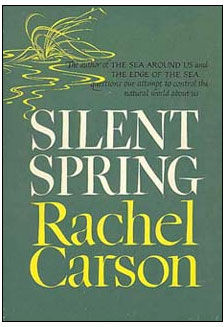
That was well understood by evolutionists early on, but it took a marine biologist and talented writer, Rachel Carson, to bring the pesticide problem to public attention and, incidentally, to launch the modern environmental movement. Silent Spring, published in September, 1962, was a brilliant book, but also one that appeared when the time clearly was ripe. The public seemingly had been primed by publicity about radioactive fallout, fears of pesticide residues on cranberries and the thalidomide scandal, the latter enhanced by pictures of infants born with distorted limbs. Carson suffered from the drawbacks of being a female scientist before science's gender gap began to dissolve, and from lacking a Ph.D and a professorial position. Despite those "handicaps," she had the science about as right as it could be at the time.
Carson was subject to a storm of vicious attacks by the combined public-relations machines of the chemical industry and agribusiness, and even from scientists in the industry and entomology departments of some universities. Typical was the much quoted statement of Professor Robert H. White-Stevens, a poultry scientist of Rutgers University:
"If man were to follow the teachings of Miss Carson, we would return to the Dark Ages, and the insects and diseases and vermin would once again inherit the earth."The assault began even before Silent Spring was published. A public relations campaign against Carson and trumpeting the safety of pesticides was bankrolled by the National Agricultural Chemical Association (NACA). Virtually all of the attacks were without merit. Carson withstood them all, even though she was struggling with metastatic cancer. I met her once only briefly, and then she was gone.
But her legacy looms huge today. Many people have the impression that climate disruption is the worst environmental problem humanity faces, and indeed, its consequences may be catastrophic. But the spread of toxic chemicals from pole to pole may be the dark horse in the race. Carson may have started environmentalism by illuminating exactly the right issue. This is especially the case as recent research has shown that many synthetic chemicals, called endocrine-disrupting compounds, may do nasty things to you at high doses but can have different harmful effects at very low doses. These low-dose effects can increase the probabilities of altered sex determination, behavioral changes, developing cancers and more.
A mass of evidence should alert humanity to the risks of toxifying Earth from pole to pole with synthetic chemicals. For instance, Tyrone Hayes of the University of California, Berkeley, has suffered Carson-like abuse by flacks for the chemical industry for demonstrating nasty low-dose impacts of the near-ubiquitous herbicide atrazine in both the laboratory and in nature. Atrazine is manufactured by Syngenta, which has bankrolled a multi-million dollar campaign hiring pundits to lie about Atrazine and besmirch Hayes. The campaign resembles that of the well-funded fossil-fuel industry assault on climate disruption and also the tobacco industry's perpetual storm of lies about the safety of smoking. Hayes has been, as was Rachel Carson, scientifically vindicated, and like Carson, is one of my heroes.
Comment: Read more about Tyrone Hayes and his research on the negative impacts of Syngenta's herbicide atrazine, in the excellent Mother Jones article: The Frog of War.

Carson was properly concerned about the problems of unknown interactions among mixtures of novel chemicals in the environment. Today, with the potential for millions of possible synergisms among the tens of thousands of compounds already released, just identifying the culprits would be an enormous challenge. And if they were identified, removing them from the environment could be an even more monumental task, or most likely prove impossible.
What should be done? In my view there are two basic solutions to situations where the activities of a segment of the human population, often an industry, present a clear and present threat to the human future as once the manufacture of chlorofluorocarbons did in threatening the ozone layer. One answer lies in society finding ways to alter the behavior of the industry to minimize the impacts on those involved. Society needs energy, but it can no longer afford to mobilize it by burning fossil fuels. John Browne had the right idea when he changed British Petroleum Corporation into BP Corporation and gave it the slogan "Beyond Petroleum." Society needs some synthetic materials, but it can no longer afford to manufacture and distribute them as incautiously as it now does.

In an era of exploding populations and escalating resource scarcities, the pressure to produce many substances with known or possible toxicities will probably grow, and grow much more rapidly than scientists can even estimate the risks. This is especially so in view of the myriad potential but unknown synergies possible in the global stew of toxic substances. One solution is to invoke the precautionary principle, by prohibiting all discharge of persistent organic pollutants and rapidly phasing out production of the most dangerous classes of compounds, such as organochlorines. This would shift the burden of proof from having to demonstrate that a chemical is dangerous to requiring it be shown to be safe, although admittedly, criteria would be difficult to establish.
The second and more fundamental answer, I believe, is that the global system needs to be rescaled. It is now in serious overshoot, with more than one Earth now required to support just today's population indefinitely. Humanity seems to be moving fast away from sustainability, and symptoms of collapse are becoming common. To see that, one need only compare the first oil well that went down 69.5 feet from Earth's surface to strike oil with Deepwater Horizon, which started a mile under the sea and drilled a couple of miles deeper. A gradual, humane reduction of human population, and a reduction in over-consumption by the rich, would greatly alleviate pressure on the chemical industry to keep churning out dangerous chemicals. I imagine that Carson, with her population-oriented discussion of pesticide problems, would be very sympathetic to such a rescaling. "Populations are kept in check by something the ecologists call the resistance of the environment," she noted, "and this has been so since the first life was created."

And perhaps they won't. Is it wise to sit by and not take substantial measures? In democracies, the decision rests ultimately with the citizens; I think it is crystal clear what Carson would have recommended.
About the author
Paul R. Ehrlich is the Bing Professor of Population Studies and President, Center for Conservation Biology, Department of Biology, Stanford University.
The 50th anniversary of Silent Spring is Sept. 27, 2012. Click here for more information on Rachel Carson.




Reader Comments
to our Newsletter